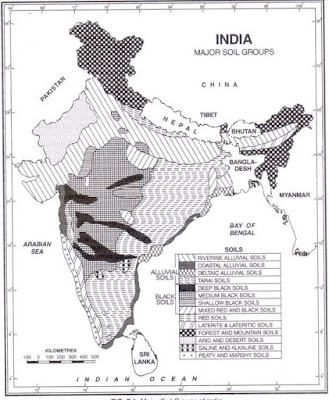Soils
The processof formayion of soils is called Pedogenesis.
The regional variations in soil composition and texture in vast country like India are an obvious outcome of variety of landforma and climatic conditions found here.
Classification Of Soils
According to ICAR (Indian Council of Agricultural Research) Soils are divided into 8 categories:
1. Alluvial Soils
They cover 24% of land surface and is found in Indo Ganga- Brahmaputra plain,costal plains and river valleys.These are also found in foothills region in plenty.It contains sand,loam,and clay in different proportion.
There are Two types of alluvial soil:
(a) Khadar - Which are newer alluvium.It is the soil deposited by the river every year. It is more fertile than the Bangar.
(b) Bangar - Which are older alluvium. It contains pebbles and calcium carbonates.
The colour of alluvial soils can be Grey, light brown or yellowish these soils are very rich in chemicals like potash, phosphoric acid, lime and carbon compounds but are deficient in Nitrogen and humus.
2. Black Cotton Soils
- The local name of these soils is Regur in Maharashtra. It is also known as 'Cotton Soil'.
- It is formed by weathering and erosion of volcanic lavas and hence found mainly in Deccan lava plateau. It is the most suitable soil for Dry Farming.
- These are Dark black in colour due to the presence of "Titaniferrous Magnetite". a compound of iron and aluminium.
- These soils show high swelling on wetting and high shrinkage on drying due to the presence of "Montmorillonite" mineral.
- These have high moisture retaining capacity, therefore suitable for Cotton, coarse grains, sunflower and citrus fruits but not suitable for crops like rice because such soils are not suitable for heavy irrigation.
- These soils are deficient in Nitrogen, humus, and phosphoric acid but rich in lime, potash, iron, aluminium, calcium and magnesium.
- Black soils are India are similar to Chernogym soils of Russia and Ukrain.
3. Red Soils
- Red soils develop generally on disintegration of crystalline and metamorphic rocks in the area of heavy rainfall.Hence are rich in ferromagnesium mineral and the Red colour of these soils is due to excessive presence of Iron Oxide (Fe2o3).
- These soils are porous and coarse grained and having low moisture retaining capacity. So, it is relatively less fertile soil and needs heavy and frequent irrigation for agriculture.
- In the low laying areas, it is found as clay and in the higher lan, It is found as unconsolidated soil.In the higher part. It is suitable for growing bazra, groundnut and Potato whereas in low lying areas, rice, ragi, tobacco and vegetable are grown in it.
- These soils are rich in iron, magnesium and aluminium compounds, but poor in lime, humus, nitrogen and phosphoric acid.
4. Laterite Soils
- It is formed in the areas of heavy rainfall (200 cm or more) due to washing away of lime and silica and these are mainly found on top of hills and mountains and humid climate such as hills of Deccan plateau, Western Ghats, top of Eastern Ghats, Assam, Mysore, Malabar & Rajmahal hills.
- These soils are not very fertile but proved to be suitable for bushes and pastures only. Within the help of fertilizer, this soils can be made suitable for the cultivation of plantation crops such as coffee, coconut, cashewnut, ragi etc.
- These soils are rich in Oxide of Iron and aluminium but deficient in nitrogen, phosphoric acid, lime and potash.
5. Mountainous or Forest Soils
- Variations are found in these soils due to various climate and ecological conitions in wich they are found. These soils contains kankars, stone pieces and pebbles, differs from places to places depending upon climate. These soils are, yet, under formation process. These are distrusted in Himalays, Vindhyas, Satpura, Nilgiri and other mountains of India.
- These are acidic in nature due to excessive presence of less decomposed humans. These soils require fertilizer for agriculture purposes. In the region of heavy rainfall, it contains more humus.Therefore, in these regions it is suitable for the cultivation of Tea, coffee, Spices and tropical fruits.
- These soils are rich in Organic matter and humus but poor in potash, phosphoric acid and lime.
6. Arid and Desert Soils
- These are distributed mainly in arid and semi - arid regions of Rajasthan. It contains sand in large quantities and is suitable for the cultivation of crops like Jowar and Bajra. But, wherever irrigation facilities are available like Sri Ganganagar of Rajasthan, wheat and cotton also grown in it.
- These soils are light in colour and contain high soluble salts and phosphorus in large quantities, but lack in carbon compounds in nitrogen.
7. Saline and Alkaline Soils
- These soils are found in area of arid and semi arid parts of Rajasthan, Punjab, Haryana, Uttar Pradesh, Bihar, Maharashtra and Tamil Nadu.
- These soils can be treated by irrigation with mixing lime and gypsum and by growing anti-salinity crops like rice and sugarcane. It can be made suitable for growing rice, sugarcane, cotton, wheat, tobacco etc.
- Excessive amount of sodium and magnesium causes salinity in the soil, while higher amount of calcium cause alcanity. So, these are unsuitable for agriculture purposes. These are deficient in nitrogen, poor in water holding capacity.
8. Peaty and Marshy Soils
- These soils are formed due to accumulation of large quantity of Organic matters under water logged conditions for long periods. These are mainly found in coastal areas like Orissa, West Bengal, Tamil Nadu and Kerala in various patches. In kerala, such soils are called Kari
- These are highly saline and deficient in phosphate and potash. So, this soils is useless for agriculture. The colour of these soils are dark, grey or black due to presence of Organic matter.

Comments
Post a Comment